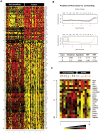Hepatocellular carcinoma displays distinct DNA methylation signatures with potential as clinical predictors
- PMID: 20305825
- PMCID: PMC2840036
- DOI: 10.1371/journal.pone.0009749
Hepatocellular carcinoma displays distinct DNA methylation signatures with potential as clinical predictors
Abstract
Background: Hepatocellular carcinoma (HCC) is characterized by late detection and fast progression, and it is believed that epigenetic disruption may be the cause of its molecular and clinicopathological heterogeneity. A better understanding of the global deregulation of methylation states and how they correlate with disease progression will aid in the design of strategies for earlier detection and better therapeutic decisions.
Methods and findings: We characterized the changes in promoter methylation in a series of 30 HCC tumors and their respective surrounding tissue and identified methylation signatures associated with major risk factors and clinical correlates. A wide panel of cancer-related gene promoters was analyzed using Illumina bead array technology, and CpG sites were then selected according to their ability to classify clinicopathological parameters. An independent series of HCC tumors and matched surrounding tissue was used for validation of the signatures. We were able to develop and validate a signature of methylation in HCC. This signature distinguished HCC from surrounding tissue and from other tumor types, and was independent of risk factors. However, aberrant methylation of an independent subset of promoters was associated with tumor progression and etiological risk factors (HBV or HCV infection and alcohol consumption). Interestingly, distinct methylation of an independent panel of gene promoters was strongly correlated with survival after cancer therapy.
Conclusion: Our study shows that HCC tumors exhibit specific DNA methylation signatures associated with major risk factors and tumor progression stage, with potential clinical applications in diagnosis and prognosis.
Conflict of interest statement
Figures




Similar articles
-
Comparison of genome-scale DNA methylation profiles in hepatocellular carcinoma by viral status.Epigenetics. 2016 Jun 2;11(6):464-74. doi: 10.1080/15592294.2016.1151586. Epub 2016 Jun 1. Epigenetics. 2016. PMID: 27248055 Free PMC article.
-
Epigenomic profiling of DNA methylation for hepatocellular carcinoma diagnosis and prognosis prediction.J Gastroenterol Hepatol. 2019 Oct;34(10):1869-1877. doi: 10.1111/jgh.14694. Epub 2019 Jun 20. J Gastroenterol Hepatol. 2019. PMID: 31038805
-
A Novel Epigenetic Machine Learning Model to Define Risk of Progression for Hepatocellular Carcinoma Patients.Int J Mol Sci. 2021 Jan 22;22(3):1075. doi: 10.3390/ijms22031075. Int J Mol Sci. 2021. PMID: 33499054 Free PMC article.
-
Integrative analysis of aberrant Wnt signaling in hepatitis B virus-related hepatocellular carcinoma.World J Gastroenterol. 2015 May 28;21(20):6317-28. doi: 10.3748/wjg.v21.i20.6317. World J Gastroenterol. 2015. PMID: 26034368 Free PMC article. Review.
-
DNA methylation in hepatocellular carcinoma.World J Gastroenterol. 2008 Mar 21;14(11):1741-8. doi: 10.3748/wjg.14.1741. World J Gastroenterol. 2008. PMID: 18350605 Free PMC article. Review.
Cited by
-
The therapeutic properties of resminostat for hepatocellular carcinoma.Oncoscience. 2018 Jun 23;5(5-6):196-208. doi: 10.18632/oncoscience.420. eCollection 2018 May. Oncoscience. 2018. PMID: 30035186 Free PMC article.
-
Analysis of methylation datasets identified significantly changed genes and functional pathways in osteoarthritis.Clin Rheumatol. 2019 Dec;38(12):3529-3538. doi: 10.1007/s10067-019-04700-4. Epub 2019 Aug 2. Clin Rheumatol. 2019. PMID: 31376087
-
Epigenetic Alterations in the Gastrointestinal Tract: Current and Emerging Use for Biomarkers of Cancer.Gastroenterology. 2021 Feb;160(3):690-709. doi: 10.1053/j.gastro.2020.09.058. Epub 2020 Dec 3. Gastroenterology. 2021. PMID: 33279516 Free PMC article. Review.
-
Aberrant DNA methylation of imprinted loci in hepatocellular carcinoma and after in vitro exposure to common risk factors.Clin Epigenetics. 2015 Feb 27;7(1):15. doi: 10.1186/s13148-015-0053-9. eCollection 2015. Clin Epigenetics. 2015. PMID: 25755686 Free PMC article.
-
Genome-wide methylation and transcriptome analysis in penile carcinoma: uncovering new molecular markers.Clin Epigenetics. 2015 Apr 18;7(1):46. doi: 10.1186/s13148-015-0082-4. eCollection 2015. Clin Epigenetics. 2015. PMID: 25908946 Free PMC article.
References
-
- Parkin DM. Global cancer statistics in the year 2000. Lancet Oncol. 2001;2:533–543. - PubMed
-
- Feitelson MA. Parallel epigenetic and genetic changes in the pathogenesis of hepatitis virus-associated hepatocellular carcinoma. Cancer Lett. 2006;239:10–20. - PubMed
-
- Herath NI, Leggett BA, MacDonald GA. Review of genetic and epigenetic alterations in hepatocarcinogenesis. J Gastroenterol Hepatol. 2006;21:15–21. - PubMed
-
- Thorgeirsson SS, Grisham JW. Molecular pathogenesis of human hepatocellular carcinoma. Nat Genet. 2002;31:339–346. - PubMed
Publication types
MeSH terms
LinkOut - more resources
Full Text Sources
Other Literature Sources
Medical

